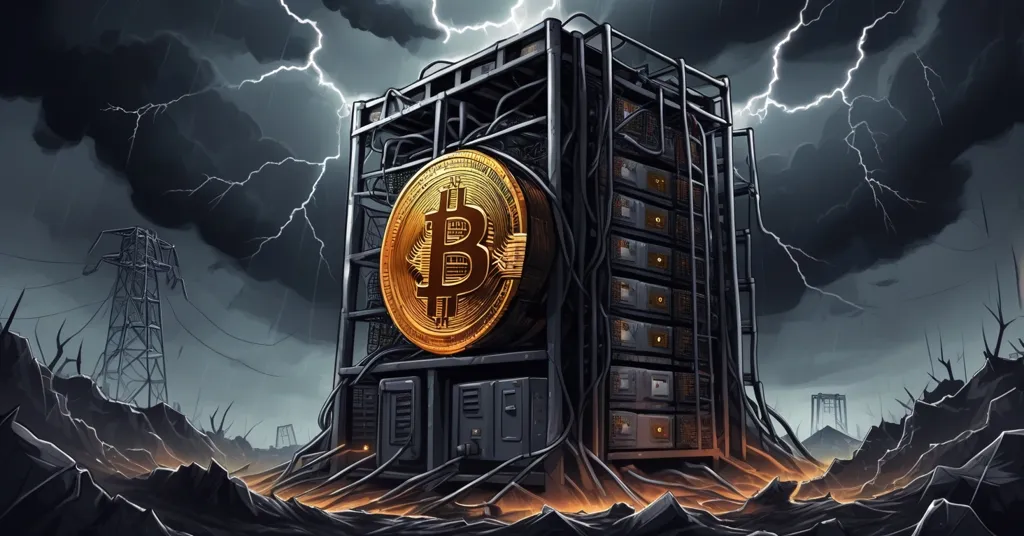Bitcoin Mining Monopoly: Could One Pool Spark a 51% Attack Disaster by 2026?

Mining Monopoly Mayhem: Could a Single Pool Trigger Bitcoin’s Next Black Swan?
Bitcoin stands as a beacon of decentralization, but a dark cloud hangs over its future: what happens if one mining pool grabs enough power to rattle the entire network? From the chilling precedent set in 2014 to the dominance of today’s giants and a looming crisis by 2026, the risk of a single pool controlling over 51% of Bitcoin’s hashrate isn’t just a thought experiment—it’s a potential disaster that could shake markets, trust, and the very ethos of crypto.
- Past Panic: GHash.io’s 51% hashrate grip in 2014 triggered a price drop and community chaos.
- Present Threat: Foundry USA and Antpool command 54-60% of Bitcoin’s hashrate in 2024-2025.
- Future Fear: A 51% breach by 2026 could spark a 10-15% price crash and regulatory clampdowns.
The Ghost of 2014: GHash.io’s Warning Shot
Let’s step back to June 2014, when Bitcoin was still a scrappy underdog in the financial world, far from the trillion-dollar titan it is today. A mining pool named GHash.io made history for all the wrong reasons by briefly seizing over 51% of Bitcoin’s hashrate—the total computing power securing the network—for about 12 hours. The impact was immediate: the price tumbled 5% from $633 to $600, and the community went into meltdown mode. On forums like Bitcointalk and Reddit, miners and enthusiasts launched desperate campaigns to pull hashrate away from GHash.io, terrified of a double-spend attack (spending the same Bitcoin twice by rewriting transaction history) or transaction censorship (blocking certain payments at will). Their efforts paid off, sort of. After a tense round-table in London, GHash.io agreed to cap its hashrate at 39.99%, a self-imposed restraint to ease fears. But the scar remained—trust in Bitcoin’s decentralization took a hit, and the market felt the sting.
The stakes were lower then. Bitcoin wasn’t yet a blip on Wall Street’s radar, and regulators hadn’t even figured out how to spell “blockchain.” Still, sharp voices cut through the noise. Early Bitcoin developer Gavin Andresen tried to calm the waters:
“Any 51% attack ‘would be obvious… and pretty easy to defend against.’”
Others weren’t so sanguine. Cornell researchers Eyal and Sirer issued a stark warning:
“GHash could ‘exercise complete control… worst of all worlds.’”
Developer Luke-Jr didn’t hold back, slamming the pool’s priorities:
“GHash [is] ‘the only major pool not discussing decentralization.’”
Even ARK Invest weighed in with a prescient caution:
“Concentration ‘reduces security by creating a single point of failure.’”
But here’s the ugly footnote: Reddit threads from the era point to blockchain evidence suggesting GHash.io may have tested its power with double-spend attempts against BetCoin Dice in 2013, mining transactions exclusively during attack windows. Whether true or not, it’s a grim reminder that 51% isn’t just a theoretical boogeyman—it’s a loaded gun, as seen in community discussions from that time on platforms like Reddit about GHash.io’s impact.
2024-2025: Mining Giants Tighten Their Grip
Fast forward to today, and the shadow of centralization isn’t just lingering—it’s damn near suffocating. Bitcoin has grown into a global asset class, with institutional money pouring in through ETFs, CME futures, and more. Yet, the mining landscape looks eerily familiar, only worse. Foundry USA, a U.S.-based heavyweight, controls roughly 30-34% of Bitcoin’s hashrate, while Antpool, tied to Chinese ASIC giant Bitmain, holds 20-30%. Combined, they dominate 54-60% of the network’s computational muscle, dwarfing GHash.io’s brief reign. For the uninitiated, hashrate is the backbone of Bitcoin’s security, the raw power miners use to validate transactions and create new blocks. When over half of it falls into one or two hands, the door cracks open for chaos—think censoring transactions, double-spending coins, or even freezing the network through selfish mining, a shady tactic where a pool hides blocks to screw over competitors. This growing concentration is a hot topic in forums like Reddit discussions on Foundry and Antpool.
Why does this keep happening? Mining isn’t a garage hobby anymore; it’s a cutthroat industrial game. Massive farms with access to dirt-cheap energy and bulk hardware crush smaller players. Then there’s the chokehold of ASIC manufacturers—specialized chips built for Bitcoin mining—where Bitmain and MicroBT control over 85% of the market. They’re not just dominant; they’re gatekeepers, flipping a middle finger to the little guy trying to mine from a basement. Add in hash-rate rental platforms like NiceHash, where anyone with cash can temporarily boost a pool’s power over 51%, and you’ve got a perfect storm for concentration. Regulatory arbitrage doesn’t help either. After China’s 2021 mining ban, hashrate flooded to North America, with the U.S. now hosting a huge chunk of global power. Foundry’s growth—up 68% annually per The Miner Mag’s analysis of U.S. hashrate trends—rides this wave, but it begs a question: is U.S.-centric mining the new fear narrative, just as Chinese dominance was a decade ago?
Meanwhile, other players like MARA Pool are climbing fast, with a jaw-dropping 168% annual growth. Is this diversification or just a fresh face to the same monopoly mess? Either way, the optics suck for a system built on being borderless and neutral.
2026 Horizon: Black Swan or False Alarm?
Now let’s peer into a crystal ball for 2026. Picture this: a single pool, maybe Foundry or Antpool, edges past 51%, even for a day. Unlike 2014, the fallout could be a bloodbath. With institutional cash tied up in Bitcoin through derivatives and spot ETFs, a breach might spark a 10-15% intraday price nosedive as algo-traders and funds panic-sell. Look at past security scares—GHash.io’s stunt shaved off 5% when Bitcoin was a speck in the market; today’s magnified exposure could double or triple that hit. Public mining firms like Bitfarms and CleanSpark might scramble to redirect hashrate to smaller pools like ViaBTC to appease shareholders, but the reputational damage to Bitcoin as a decentralized fortress would already be done. The potential impact of a 51% attack on price and trust is a real concern for the ecosystem.
Regulators, already circling like vultures, could swoop in hard. The U.S. CFTC might launch hearings on concentration risks, while FinCEN could slap dominant pools with “systemic payment utility” labels, dragging them under tight oversight. The EU’s MiCA framework might demand hashrate transparency reports, and China’s Cyberspace Administration could choke ASIC exports or eyeball Antpool’s operations. Even back in 2014, the U.S. Treasury flagged early concerns:
“Bitcoin anonymity plus potential illicit use ‘is an issue of law enforcement… statutory review underway.’”
But here’s a twist: would a pool actually pull something malicious like a double-spend or censorship spree? Pure self-interest might say hell no. Tank trust in Bitcoin, and its value—and their revenue—crashes. Still, perception is everything in markets. As Vice put it bluntly:
“Bitcoin is no longer decentralized… needs fixing to survive.”
Even without an attack, the stench of centralization could scare off adoption and invite regulatory overreach. And there’s another wildcard: U.S. policy chatter in 2024, like EIA surveys, obsesses over mining’s energy footprint more than hashrate concentration. Policies targeting power-hungry farms could push hashrate to unregulated backwaters, ironically deepening centralization. If Wall Street dumps ETF shares over a 51% scare, will regulators care more about carbon emissions than network security? Insights on mining monopolies as a potential black swan event highlight these looming risks.
Fighting Back: Tech, Community, and Hard Realities
Hope isn’t dead yet. Bitcoin’s community and developers are cooking up countermeasures. Stratum V2, a protocol upgrade, encrypts job selection so miners—not pools—pick their block templates, slashing a pool’s ability to dictate terms. BraiinsOS offers auto pool-hopping firmware, letting miners bounce between pools dynamically to balance hashrate. Blind-merge mining and other geeky tricks are also in the pipeline. These tools give smaller miners a fighting chance to push back against giants, as explored in expert opinions on Stratum V2 and BraiinsOS effectiveness. But let’s not kid ourselves—systemic drivers like cheap energy deals and ASIC oligopolies aren’t easily broken. And while grassroots grit on forums saved the day in 2014, today’s world of corporate miners and institutional stakes might not bend to a Reddit uprising.
There’s a deeper tension here, straight from Satoshi’s whitepaper: Bitcoin’s fight against centralization is a tug-of-war between pure ideology and brutal economics. Some maximalists argue it’s not a fatal flaw as long as nodes keep the blockchain censorship-resistant. Others see it as a betrayal of the vision—a slow rot that could turn Bitcoin into just another centralized toy for the powerful. Tech like Stratum V2 shows promise, but without mass adoption or a dent in economic incentives, it’s a Band-Aid on a gaping wound. And if energy regulations shove hashrate into darker corners of the globe, we might be trading one monopoly for another. For a deeper dive into these challenges, check out perspectives on mining pool dominance and security risks.
Key Takeaways: Unpacking the Centralization Crisis
- What is a 51% attack in Bitcoin mining, and why does it matter?
It’s when one entity controls over half of Bitcoin’s hashrate, letting them manipulate the blockchain—double-spending coins, censoring transactions, or freezing the network. This guts trust, risks price crashes, and could trigger regulatory heat. - Why does Bitcoin mining centralization keep rearing its ugly head?
Economies of scale, dirt-cheap energy, and ASIC monopolies by Bitmain and MicroBT push miners to big pools like Foundry USA and Antpool, who together hold 54-60% of hashrate as of 2024-2025. Hash-rate rentals via NiceHash only make it worse. - How did GHash.io’s 2014 dominance shake Bitcoin?
Their brief 51% control caused a 5% price drop and mass panic, exposing centralization flaws. Community pressure forced a 39.99% cap, but trust and market confidence were already bruised. - What’s the worst-case scenario for a 51% breach by 2026?
A 10-15% price crash could hit as institutional players dump holdings via ETFs and derivatives, while regulators like the U.S. CFTC or EU’s MiCA pile on with oversight, and Bitcoin’s decentralized rep takes a beating. - Can tech solutions break the mining monopoly cycle?
Tools like Stratum V2 for miner-controlled blocks and BraiinsOS for pool-switching offer real hope, but they’re up against entrenched economic incentives. Widespread adoption is the hurdle. - Is U.S.-based mining dominance the next big fear for Bitcoin?
Damn right—with Foundry USA at 30-34% post-China’s 2021 ban, critics are shifting FUD from Chinese pools to North American concentration, risking Bitcoin’s image as a truly borderless system. For further insights into potential damages, explore what a 51% attack could mean for the network.
Bitcoin’s been through hell before, and it’s still standing. The real question isn’t just whether a single pool could unleash a black swan event—it’s whether the community, developers, and even the suits can move fast enough to keep decentralization from becoming a quaint memory. As the hashrate tug-of-war rages on, staying sharp and backing decentralized solutions has never been more critical. Keep your nodes running; the next block in this saga is already being mined.



